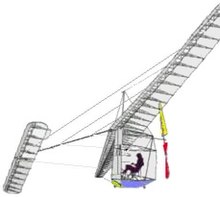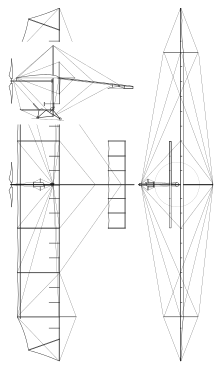Gossamer Condor

The Gossamer Condor was the first of a series of successful muscle-powered aircraft built by a team led by Paul McCready .
With this, on August 23, 1977, the first Kremer Prize for continuous, controlled flight with muscle power was won. The condition was a flight with a muscle power aircraft in the form of a recumbent figure eight, 806 meters apart, within eight minutes of each other. After the start, a 3.05 m (10 ft) high obstacle has to be overflown, which in the end also serves as a target.
During the development of the aircraft, the assumption was made of unearthed wings with just a simple foil covering (above) and numerous tasks and problems were solved over several versions. On the one hand, the maximum power of 400 watts that a trained athlete could apply for a longer period of time must not be exceeded. In order to be able to fly with such low power, the aircraft needed a wingspan of 29 meters, more than that of a DC-9 . It could not weigh more than a third of a normal glider.
On the other hand, the profile of the main wing, like almost all profiles, showed a torque around the transverse axis which, without compensation, would have led to a lowering of the nose and thus to a crash.
Normal aircraft compensate this torque with the horizontal stabilizer . Flying wings either need a profile with a strong S-flap or, like the hang glider, a clear sweep that makes the outer part of the wing look like a tail. In duck-winged birds, the duck wings are used to compensate for the torque. The efficiency advantage of the duck wing (horizontal stabilizer in the front) compared to a conventional design is that it generates lift itself. On the other hand, a conventional rear horizontal stabilizer would have to be set to downforce.
There was also a control problem with the long areas. Ailerons or movable flaps at the ends of the extra-long wings seemed too problematic to control. The solution was the controlled twisting of the ends of the wings using wire tension to fly the turns.
Paul B. MacCready and Peter Lissaman , both from Pasadena , California , designed the Gossamer Condor, whose hull was constructed from thin-walled aluminum tubing. The wing nose was made of corrugated cardboard and expanded polystyrene. The entire surface structure was covered with a thin layer of Mylar (polyester film) at the top and bottom . The pilot sat in a semi-recumbent position in the cabin; both hands were free to control the plane. A central mast served to brace the wing with piano wire ( steel ) downwards and upwards. The airplane with its wide- stretched wings was designed exclusively for flight with human muscle power. This relatively primitive and fragile Gossamer Condor was the first truly successfully operated, maneuverable, human-powered aircraft.
- Wingspan 29.25 m (96 ft.)
- Length 9.14 m (30 ft.)
- Height 5.49 m (18 ft.)
- Mass 31.75 kg (70 lb.)
To win the 1st Kremer Prize on August 23, 1977, cyclist and microlight pilot Bryan Allen took off at 7:30 a.m. from Shafter Airport, Shafter , California, and landed again in 7 minutes and 27.5 seconds. In doing so, he flew a prone figure eight around two pylons half a mile apart, at a height of three meters at the beginning and at the end. The Gossamer Condor covered a total distance of 1.35 miles (2.16 km) at a speed of ten to eleven mph (16 to 17.6 km / h). A power of ⅓ HP (about 245 W) was required.
After winning the 1st Kremer Prize, the aircraft is now in the Smithsonian Institute's National Air and Space Museum , Washington, DC
The development and construction of the plane was filmed in 1978 in an Oscar-winning short documentary ( The Flight of the Gossamer Condor ).
literature
- MacCready, PB et al., Gossamer Condor Plans , Aerovironment inc., 1978.
- MacCready, PB, Jr., Flight on 0.33 horsepower: The Gossamer Condor. , AIAA paper 78-308. AIAA 14th Annual meeting, Washington DC, February 7-9, 1980.
- Lissiman, PBS, Jex, HR and MacCready, PB Aerodynamics of Flight at Speeds Under 5m / s , Man-Powered Flight the Channel Crossing and the Future. (London: The Royal Aeronautical Society, February 1979.)
- M. Grosser, Gossamer Odyssey , Dover Publications, Inc., ISBN 0-486-26645-1 , 1981.
Web links
- Gossamer Condor at the Smithsonian Institution's National Air and Space Museum
- Flight of the Gossamer Condor. Film by Ben Shedd (1978) from the archive of the San Diego Air and Space Museum on Youtube (27:20 min.)

